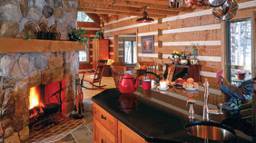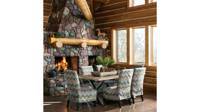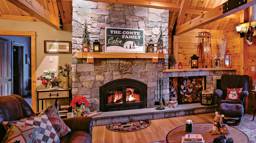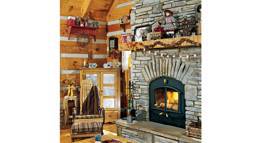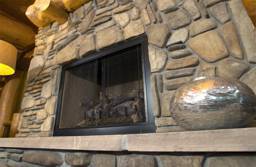With its dance of light and heat, fire has long symbolized life. But even more than a mere symbol, the magical flames mimicked life with the qualities of birth, growth and death. This strange quality led primitive man to worship fire as a deity that had life-giving power. And with good reason: It did. Fire provided light during the long, dark winter months, not to mention protection from the fierce, wild animals and freezing temperatures?and let's not forget imparting that delicious char-grilled flavor! The hearth has long been deemed the very heart of the home. Even though millennia have passed and, with them, the invention of never-foreseen technology including microwave ovens and forced-air heating systems, we still seem to have an innate, if not primal, need for fire.
The cozy glow of the hearth with its crackling fire has an alluring embrace on family and friends alike, causing everyone to gather around and ignite into lively conversation with tales that need to be told. With such an important role, careful consideration must be given to the materials used to construct and decorate your fireplace. A myriad of options are available. Whether you desire a rustic river rock fireplace soaring through the cathedral ceiling of the family room or perhaps something a bit more intimate, there is a fireplace facing that suits any mood or design.
A Face that Fits

Photo: Brandon Malone Log Provider/Designer: Honest Abe Log Homes Interior Designer: Molly Cooper, Cooper & Co. See more here.
Because of this proliferation of prefabricated fireboxes, design of the fireplace facing becomes ever more important to achieve the appropriate appearance when working with hearths in today's log homes. Fireplace facings fall into two categories: natural and man-made. The most obvious natural facing is stone. But natural stone is just the beginning. When dealing with natural stones, like granite, marble or limestone, there are further options to be considered. The look and feel of your design scheme will help with these decisions.
Slab Materials: Granites and Marbles

Stones

Photo: Brandon Malone Log Provider/Designer: Honest Abe Log Homes Interior Designer: Molly Cooper, Cooper & Co. See more here.
Along with flat slabs and tiles, stone is available in split blocks. Similar to bricks, blocks of stone are laid in courses. With a chiseled, rustic face, these blocks lend a very appropriate air to the design of fireplaces in log homes. They bridge the gap between found, random-shaped stones and quarried material.
River Rock and Fieldstone

Photo: Heidi Long, Designer: J. Logan Architects, Log Provider/Builder: Hilgard Log Builders / See more here.
River rock and fieldstone also are popular options when creating a rustic facing for the fireplace. Think of fieldstone as one large, organic jigsaw puzzle waiting to be assembled. If you are fortunate enough to have stone on your property, this is a great way to literally tie your home to its surroundings by using it to face your home's fireplace. Whereas most fieldstone is rather flat - or at least angular - river rock is round. Water erosion has worn the stone into soft, rounded shapes. These small boulders make a naturally graphic statement when stacked together to create a soaring fireplace.
Finish
Finish is an important factor, too. Much like choosing the paint finish for your home, stone surfaces run the gamut, from shiny to matte. Polished stone, like marble, is the most reflective and may not be appropriate for a log home. But there are various processes that can be applied to stone to reduce its sheen. Honing or acid-washing dulls the surface and creates a more textural finish.
Fireplace Surrounds
Ceramic Tile
Related to brick is, of course, ceramic tile. Whether clay or porcelain, tile creates a pleasing geometric grid. And not all tile is flat. High relief and sculpted tile can add just the right nuance to a log home fireplace. In lieu of a surround, terra cotta corbels can hold up a rustic beam to create a mantel. Small touches such as these are ways of adding detail to a fireplace without overwhelming it. Not all tile has to come from an artist in a studio. You can create your own tile designs. Ready-made tile can be painted and baked to produce one-of-a-kind art. Available at art stores, ceramic paint bakes to a durable finish in a standard oven. The technique works best on glazed tile, as the paint colors will remain much more vivid after baking than on unglazed tile. And, you've personalized your home.Cast Stone
Rounding out the man-made materials is cast stone, which has found recent popularity among home builders and remodelers alike. Cast stone is a lightweight concrete formed in sections and grouted together. Typical surrounds are composed of six to eight pieces, including leg, mantel and hearth sections. When secured to the wall and grouted, these surrounds rival the best hand-carved limestone mantels?at a fraction of the cost. Cast stone is tinted so the color runs through the entire piece. If extra distressing is required, it can be lightly sanded to sharp edges. And it's easily aged with stain or paints for a deeper, richer patina. With such a variety of natural and man-made materials now available, there is a fireplace surround to suit every design need and budget. The right facing truly can add life to your home's hearth.








